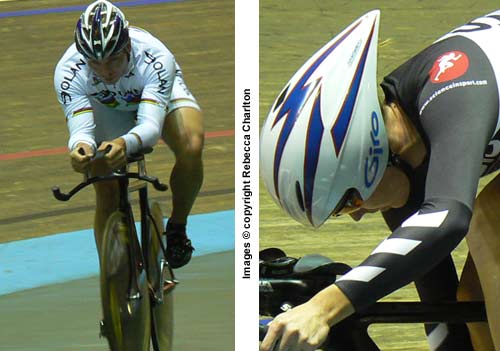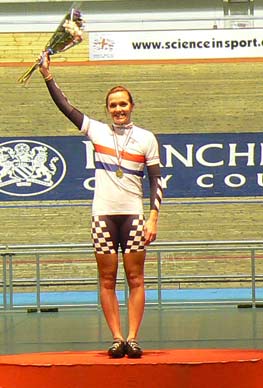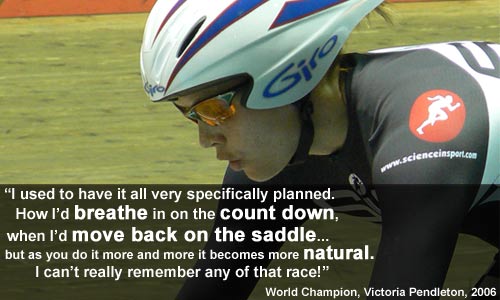|
|
You may expect a girl who is cleaning 75Kg in the gym and powering round a track faster than any other woman in the world, to be quite well built. Big thighs? Huge shoulders? Well you’d be wrong. Victoria Pendleton defies all stereotypes associated with track sprinters and is actually one of the most petite athletes on the world stage.
We had a chat to Victoria at last year’s National Chapionships after she took the 500m TT title to find out just how she does it. We re-visited her a year on as she yet again, took the National title for the 500 TT, the Sprint, the Keirin and the Scratch at Manchester Velodrome. Here’s what she had to say…
First of all, congratulations!
Thank you, well I’m very surprised actually because I was just sitting there with my dad before saying I’ve got no idea what I’m going to do. I haven’t done a 500 since the Worlds, so, they were in April! Quite a long time ago really. So yeah really surprised as I didn’t really know what I was going to do.
|
|
“I’m not a straight sprinter you know, I’m not a big burley thing.”
Do you remember what your first 500m time was?
No idea actually, no idea to be honest, I used to ride the grass and we didn’t used to do the 500. It was the 800 we used to do or the 400, we never really did the 500 so it’s a bit hard to say really. I think it must have been 40 second something, it wasn’t far over 40. I don’t really ever remember doing anything like a 42 or a 44 ever so I think it was always around that 40ish. And then I remember coming down to about 38 and I was like ‘come on!’ Those first one’s are like really big chunks and then it starts to get smaller and smaller to get the next bits off. I think the kind of effort you have to put in to get it from like a 38 to a 37 is a lot. The amount from a 37 to a 36 is just massive and then it just gets more and more and more proportionally, to take the time off.
How often are you timing yourself before a 500TT?
Well to be honest we rarely go the full distance. I only really do the 500 full distance in a race situation, standing start, in big competitions like at the World Cup. We usually do about five or six a year, seven maybe. I mean I do lots of intervals on bigger gears, not like we’re racing but you know, I don’t really do 500’s much in training.
Is the transition between accelerating standing up and sitting down something you’ve had to work on?I think so yeah. I mean it becomes automatic after a while, I mean you do so much work out of the saddle anyway, for the 200m and stuff like that. I don’t know how it comes together, it just does.
So, do you think about sections of the race before you race?
I used to. I used to have it very specifically planned. How I’d breathe in on the count down, when I’d move back from the saddle, because I’d move back on three in anticipation of using my body weight to sort of launch me out of the gate. And then I’d just think about the first quarter of the turn, then I’d think about the half and then it’s just transition and then drive all the way home.
It’s weird like, it’s important to get the most of each section. You have to look at it in blocks but as you do it more and more it becomes more natural like I can’t really remember any of that race. I saw number six on the clock and that’s when I breath in and then I know that I’m going to breath back on one breath and then you go.
 |
Do you find that your first 250m always determines a good time?
I think because I’m not a straight sprinter you know, I’m not a big burley thing. My first lap, on an international level is actually quite poor, my second lap is where I manage to make it up. Compared to other women in the World my second lap is actually quite fast, it can be quite deceiving.
They talk about a sprinter having a really good start don’t they?That’s how you should do it, hit out, you know really hit peak power within the first lap, then you fade out towards the 500. That’s ideally how you train, but for some people like myself, I’m not a true sprinter, but I’m sort of a hybrid really.
 |
It’s important for me to initiate my sprint early In a race because I know I’ve got quite a long sprint, like my sprint endurance is quite good. So, obviously playing to my advantage I would try and make a true sprinter, you know, like a big burley Russian go before they want to because that would be playing to my advantage and hope that they fade before the end, so yeah that would be how I’d approach it.
After all your international competitions, how do you feel in the approach to Nationals – do you still get nervous?
It’s very difficult, I still get nervous which is just ridiculous but because obviously I still want to perform. I don’t want to be beaten even though it’s the wrong time of year for me, but it’s a bit of a social affair, it’s nice to catch up with people, I have to say I’ve got to stop chatting and warm up otherwise I’d never be ready for any of my races.
Do you have any pedalling drills or advice for pedalling?I think, for road and track, keep your knees in. A lot of people ride with their knees out all over the place which is very un-aerodynamic. Try to keep them close to the top tube, it’s becomes automatic and it shouldn’t be uncomfortable but a lot of people ride with their legs too parallel and it may look nice when they look down on themselves but you know, keep you legs and knees in and also, keep your elbows in, you’ve got to keep tucked in. I think with track your core has to be strong, you’re using a whole lot more force but you have to ensure that your middle isn’t wobbling, keep peddling and get the most out of your ride, so yeah core stability and just keeping your elbows in.
|
|
“For a squat my max is 120 kilos. I weigh 60 so that’s twice my weight. I could actually compete as a weight lifter in my weight category, as a sort of county lifter.”
Can you give us five top tips for aspiring sprinters?1. Learn to love the gym.
…ooh, sorry to interupt but what can you lift?
For a squat my max is 120 kilos. Normal Olympic style bar with 120 kilos, and my power clean is about 75. I weigh 60 so that’s twice my weight. I could actually compete as a weight lifter in my weight category, as a sort of county lifter.
2. Learn free-weight technique in the gym, if you can, if you’ve got a coach, a strength and conditioning coach.
3. Get that protein down you. Protein intake is very important.
4. Use road as recovery. Learn to rev on the road, pedal fast and smooth.
5. Work on your core stability.
Goals – how many can you realistically have in a season?
Ah… specifically, I’ll prepare to be on form for one occasion in the year. A double peak is possible, obviously if you’ve got Commonwealth Games and Olympics then you’ve got no choice and Worlds. But literally only two, maximum two peaks. I’ll do other events, I will slightly taper for them, I will give myself two days for those but I won’t actually train for those events, I will use them as training.
So for an important event would you taper for a week?Yep. So yeah, I will have about a month off the gym and two weeks of literally doing going on the track doing something everyday but only small and intense, two or three sprints and go home.
And what about the day before complete rest?
Usually, the day before I’ll actually do a session on the turbo, but the day before that, rest, usually.
Right, well we’ve been taking notes! Look out for our interview with Paralympic Champion Sarah Bailey to follow soon…







